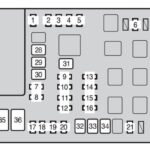Modern vehicles are sophisticated machines, relying heavily on computer systems for optimal performance and emissions control. At the heart of this intricate network is the OBD2 system, or On-Board Diagnostics II. This system acts as the car’s internal health monitor, constantly tracking various parameters to ensure everything is running smoothly. The primary function of your Computer Obd2 system is to monitor your vehicle’s emissions and other critical diagnostic data. This capability offers significant advantages for both car owners and automotive technicians alike.
Alt text: Close-up view of a vehicle’s OBD2 port, highlighting the standardized 16-pin connector used for accessing computer diagnostic information during car maintenance and repair.
One of the most crucial benefits of a computer OBD2 system is its ability to detect potential problems early on. By continuously monitoring various sensors and systems, the OBD2 computer can identify fault conditions before they escalate into serious and costly repairs. When an issue is detected, the system stores diagnostic trouble codes (DTCs) that pinpoint the source of the problem. This data is invaluable for mechanics, allowing for faster and more accurate diagnoses. Furthermore, computer OBD2 systems can record “freeze frame” data, which captures the sensor readings and operating conditions at the moment a fault occurred. This snapshot provides critical context for understanding intermittent issues.
Beyond fault detection, computer OBD2 systems also provide real-time access to a wealth of vehicle data. Using a scan tool, which interfaces with the OBD2 computer via the diagnostic connector, users can monitor live parameters such as engine speed (RPM), vehicle speed, engine temperature, and fuel system status. This real-time data can be used to assess vehicle performance, diagnose driveability issues, and even calculate fuel efficiency.
The OBD2 diagnostic connector itself is a standardized 16-pin port, typically located within easy reach on the driver’s side of the dashboard, usually beneath the steering column. This standardized location and connector type ensure compatibility across virtually all modern cars and light trucks. To access the wealth of information stored and processed by the computer OBD2 system, a scan tool is essential.
Scan tools come in two main varieties: stand-alone devices and PC/Mobile-based systems. Stand-alone scan tools are self-contained handheld units. While convenient in their simplicity, they often have limited functionality, lack advanced diagnostic features, and can be expensive for their capabilities. They also generally cannot be upgraded to support newer vehicle models or diagnostic protocols.
In contrast, PC/Mobile-based scan tools offer a more versatile and powerful diagnostic solution. These tools consist of an interface adapter that connects to the vehicle’s OBD2 port and communicates with a computer, smartphone, or tablet running specialized OBD software. The connection between the adapter and the computer device can be established via USB, Bluetooth, or Wi-Fi. PC/Mobile-based scan tools leverage the processing power, display capabilities, and upgradeability of modern computing devices. This approach results in more feature-rich diagnostics, software updates to support new vehicles, and often a more cost-effective solution compared to stand-alone tools. For users seeking comprehensive computer OBD2 diagnostics, PC/Mobile-based options are generally the preferred choice.
In conclusion, the computer OBD2 system is a vital component of modern vehicles, providing essential diagnostic capabilities and real-time data access. Understanding the role of the OBD2 computer and utilizing appropriate scan tools are crucial for effective vehicle maintenance and repair, whether you are a professional technician or a car owner interested in understanding your vehicle better.
